Synergy between science and engineering enables exceptional results
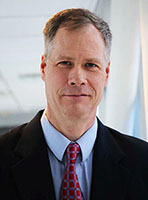
With an undergraduate degree in electrical engineering and systems science and graduate degrees in computer science and mathematics, Div. 1000 VP and Chief Technology Officer Rob Leland has a foot in both cultures, science and engineering.
Engineering deeply rooted in science is a common theme permeating much of Sandia’s work. The intentional cross-pollination between scientific disciplines and the practical application of the resulting insight to challenging engineering problems is one of Sandia’s great strengths and underpins our value proposition to sponsors and customers alike.
Perhaps less appreciated are the cases in which our engineering skills enable a new frontier in scientific discovery. On the occasion of Engineers Week, I’d like to share a few of these stories, and thereby offer the perspective that there is actually a virtuous cycle, a deep synergy, between science and engineering that often enables our most exceptional results.
The Red Storm story: Engineering to enable world-class computational science
In 2001, Sandia was seeking to acquire a new supercomputer, and the procurement was off to a rocky start. The Labs had issued a detailed request for proposals for the new system, but neither of the proposals received met the requirements. One of the companies, however, was willing to work with Sandia to build a system to the Labs’ architectural specifications.
Sandia ultimately awarded the contract to that company, Cray Inc., and over the next 30 months Sandia scientists and engineers worked side by side with Cray personnel to create the new system, code-named Red Storm. Completed in 2004, Red Storm served as Sandia’s primary high-performance computing resource for the engineering and science needed to maintain the nation’s nuclear weapons stockpile, and also was used on occasion to meet other critical national security needs. For example, in 2008, Red Storm played a crucial role in enabling the US military to shoot down a defective satellite that threatened to fall to Earth.
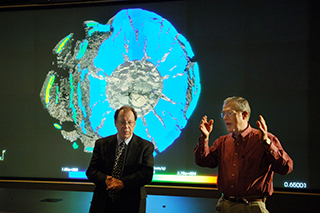
Red Storm was envisioned by Bill Camp (right), director of Sandia’s computing research efforts at the time, and Jim Tomkins (left) Sandia’s lead computing architect of that era. CTO Rob Leland served as the responsible senior manager for the effort. (Photo by Randy Montoya)
Very successful in the broader marketplace
For the complex engineering simulations it was designed to run, Red Storm was the world’s fastest supercomputer. It also proved very successful in the broader market due to its ability to effectively and efficiently solve a wide range of scientific and engineering problems. In fact, over the subsequent decade, the family of systems based on the Red Storm prototype became Cray’s most successful product line in history, with more than 120 descendants around the world.
I believe Red Storm’s success came about most fundamentally because Sandia is an outstanding engineering institution. That, and the experience gained in the development and use of several previous generations of leading-edge supercomputing platforms, translated into a clear design philosophy and sound judgment about just how far to push the state of the art — far enough to achieve breakthrough performance but not so far as to become untenable in that technological era.
This design philosophy led ultimately to a step-change in the depth and breadth of computational science that could be performed at national laboratories, universities, and companies around the world; hence, this is a great exemplar of engineering in the service of scientific advancement.
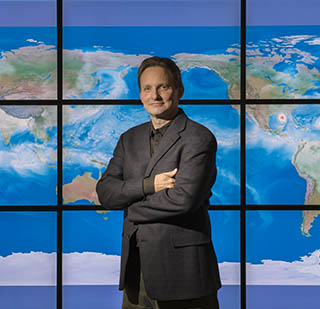
Atmospheric climate model simulation performed by Mark Taylor used Sandia’s atmospheric modeling code on Jaguar, the Oak Ridge National Laboratory system derived from the Red Storm architecture. At the time this was the most detailed global atmospheric simulation performed to date and led to new insights regarding global precipitation patterns. (Photo by Randy Montoya)
Scientific windfall
One example of this scientific windfall is the atmospheric climate modeling simulation work performed by Sandia’s Mark Taylor. Access to Red Storm allowed Mark to develop the spectral element method into one of the fastest and most scalable global atmospheric models available. He went on to integrate this into the Community Earth System Model as part of Sandia’s Energy & Climate program work for DOE’s Office of Science. This made it possible to perform high-resolution climate simulations on Jaguar, the Oak Ridge National Laboratory supercomputer based on the Red Storm architecture. At the time, these were the most detailed global atmospheric simulations that had ever been performed, and it is expected that this capability will be used in the next round of climate studies performed for the Intergovernmental Panel on Climate Change in support of global climate treaty negotiations.
The model is currently being used on today’s fastest supercomputers, many of which continue to be Red Storm-derived systems. This work is now an integral part of DOE’s program to develop an Earth system model that will make use of future supercomputer architectures to address climate science issues such as the impact of climate change on freshwater supplies in the US and the stability of the Antarctic ice sheet.
To complete the arc of this story, it is important to note that many of the scientific advances enabled by Red Storm led, in turn, to important advances in the engineering of materials, components, and systems in a virtuous cycle that continues to this day.
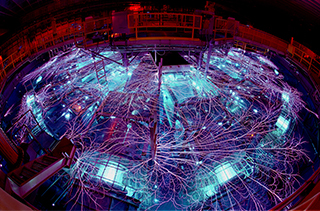
Sandia’s Z machine: Engineering to support world-class experimental science
Sandia’s Z machine is another important example of this symbiosis between science and engineering. Here, excellence in the engineering of experimental (rather than computational) facilities has enabled world-class scientific research.
Z’s origin dates back to Sandia’s pulsed power research of the 1960s. Sandia was exploring the use of pulsed power — the generation of high-power energy pulses — for conducting nuclear survivability and hardness testing and for the measurement of material properties in the extreme environments generated by nuclear detonation. Sandia’s research in this area spawned the Particle Beam Fusion Accelerator or PBFA-I, and several other exotic experimental facilities. In 1997, PBFA-II was upgraded to PBFA-Z, or more simply the “Z” machine, named after technology that uses an electric plasma current flowing in the vertical direction (labeled the Z axis by mathematical convention) to generate a magnetic field that “pinches” (compresses) plasma around this axis.
A multi-decade effort
When an upgrade of Z was begun in 2006, Sandia used its exceptional engineering skills to design and deploy an even more powerful machine. This multi-decade effort in pulsed power engineering and science today enables scientists to generate electrical power bursts that, for a few billionths of a second, exceed the entire world’s normal generating capacity by a factor of five. This enormous power is used to create extreme states of matter, producing pressures more than three times that at the center of the Earth, and temperatures more than twice that at the center of the sun.
Z experiments have advanced our scientific understanding of materials used in the nuclear weapon stockpile, such as plutonium, and of commonplace elements such as hydrogen that form the bulk of giant planets like Jupiter. The Z pulsed power system also compresses and heats deuterium in tests aimed at creating a new approach for achieving thermonuclear fusion in the laboratory. This approach, called Magnetized Liner Inertial Fusion (MagLIF), has already achieved significant fusion yield and was recently selected by DOE as one of three main approaches to achieving fusion. In addition to these core mission efforts, a small fraction of Z experiments are devoted to more exploratory scientific research, which strengthens the connections between Sandia and university communities, and attracts future stockpile stewards.
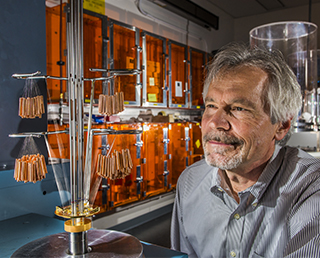
Physicist Jim Bailey observes a wire array that will heat foam to roughly 4 million degrees until it emits a burst of X-rays that heats a foil target to the interior conditions of the sun. Working at Sandia’s Z machine, Jim and his team have been able to determine experimentally, for the first time in history, iron’s role in inhibiting energy transmission from the center of the sun to near the edge of its radiative band. (Photo by Randy Montoya)
Answering previously mysterious questions
One example of such research is Jim Bailey’s investigation of stellar opacity, the property of matter that controls radiation transport inside the sun. These experiments on Z have reproduced the 2.2 million degrees kelvin temperatures at the edge of the solar radiation zone and answered important and previously mysterious questions regarding the evolution and structure of the sun. Jim’s research team was recently recognized with a Lockheed Martin NOVA award and an NNSA Defense Programs Award of Excellence, and has received broad public attention that included a National Public Radio story.
Conducting experiments like these in Z’s extreme environment is only possible due to leading-edge, highly innovative engineering. One example of this engineering is the development of an explosively driven, “ultrafast” closure valve.
The valve allows millions of amperes of current to pass into a containment vessel through a vacuum gap. The valve then pinches off and hermetically seals this gap before the exploding material can escape from the containment vessel. Another example is the development of the world’s fastest digital framing camera, the result of a marriage of capability between Sandia’s Microsystems and Engineering Applications (MESA) facility and Z. The camera can take multiple X-ray images at a rate of up to a billion frames per second. This transformative capability allows scientists to observe the evolution of fusing plasmas at a resolution never before possible.
The persistent challenge and opportunity of two cultures
These are just a few examples of Sandia’s successful coupling of science and engineering: Advances in science often lead to engineering breakthroughs, which, in turn, enable scientific advances that were previously not possible. This success, however, is not a given.
In his famous 1959 lecture, British chemist and novelist C.P. Snow observed that there are two separate and distinct world-views held by those who train in the physical sciences and those educated in the liberal arts. He argued that because relatively few people had direct experience in both cultures, a breakdown in communication and trust often arises, and that this presents a major barrier to addressing the world’s problems. Snow’s essay, “The Two Cultures,” sparked widespread debate that continues to this day.
In my view Snow’s argument has relevance for Sandia today. In fact, Snow later published a more extensive version of his essay in which he describes a similar cultural tension between discovery-oriented scientists and delivery-oriented engineers. His prescribed remedy is the same as in his earlier work: We are called to develop mutual respect and empathy between the two cultures. Part of my vision for Sandia is that we continually strive to present an exemplary model of this mutual respect and empathy. As our history clearly shows, when Sandia honors this ideal and leverages the combined strengths of its scientific and engineering cultures, we achieve exceptional results on behalf of the nation.